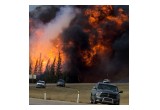HSTL Modular Buildings Ready for Disaster Recovery

DALLAS, May 18, 2016 (Newswire.com) - To meet the high demand for temporary space needed by communities recovering from disasters, HSTL Modular (www.HSTLModular.com) is forming a North American network to quickly deliver modular buildings, office trailers, and temporary homes to support all aspects of community disaster recovery.
The HSTL Modular rapid recovery network uses advanced predictive systems to help determine when and where disasters are most likely to occur. Then, HSTL Modular moves its resources into place so that sudden demand can be met.
First, are the communities likely to recover from a disaster and, if so, how do they acquire the resources needed to replace those that were destroyed?
HSTL Modular Disaster Recovery Network
For example, high-value counties in New Mexico, California, and other western states are currently showing up in HSTL Modular predictive reports as the 2016 wildfire season gets underway there. These reports help set up high-priority support pipelines.
Before disaster strikes, the recovery network signs call-when-needed agreements with key recovery stakeholders in local jurisdictions. These agreements save time establishing the right chains of command, chains of communication, and recovery operating procedures.
Stakeholders include elected officials, public safety agencies, community leaders, providers of recovery workers, and citizen groups.
Upon signing, HSTL Modular's role is to prepare for the fastest possible delivery of recovery facilities to communities if and when they are hit by disaster. As seen in Fort McMurray, Alberta, recently devastated by an out-of-control megafire, a community may suddenly have an urgent need for hundreds of recovery modular buildings and mobile offices.
The call-when-needed agreements facilitate pre-disaster planning as a free network service. They address four community disaster recovery questions of greatest concern to emergency managers:
First, are the communities likely to recover from a disaster and, if so, how do they acquire the resources needed to replace those that were destroyed?
Second, what happens to households, businesses, and government agencies as they struggle to recover?
Third, what can communities do to promote a more rapid, complete, and equitable recovery?
And fourth, what can communities do to reduce their hazard exposure and make themselves more resilient when extreme environmental events occur?
HSTL Modular's relocatable buildings and portable offices support disaster recovery functions at all stages of recovery.
During the disaster assessment stage, HSTL Modular facilities are ready to be first on the scene for expedited assessment, preliminary damage assessment, site assessment, victims' needs assessments, and local recovery meetings to review lessons learned.
Next, during the short term recovery stage, temporary space is central to functions dealing with impact area security, temporary shelter and housing, infrastructure restoration, debris management, emergency demolition, repair permitting, donations management, and disaster assistance.
Long term reconstruction is the next stage, focusing on hazard source control and area protection, land use practices, building construction practices, public health and mental health recovery, economic development, infrastructure resilience, historic preservation, environmental recovery, and disaster memorialization. Those in charge of these issues can benefit from the availability of temporary space throughout the community.
In addition, recovery management is an overarching set of functions dealing with agency notification and mobilization, mobilization of all recovery facilities and equipment, internal direction and control, external coordination, public information, recovery legal authority and financing, administration and logistical support, and documentation. HSTL Modular move-in ready backup sites make it possible to immediately set up a networked recovery operation.
For more information about joining the HSTL Modular Disaster Recovery Network, call John Simmons, Network Administrator, at 1-800-810-4030.
Contact:
John Simmons
Network Administrator
Disaster Recovery Network
HSTL Modular
johnsimmons@hstlmodular.com
1-800-810-4030
Source: HSTL Modular




